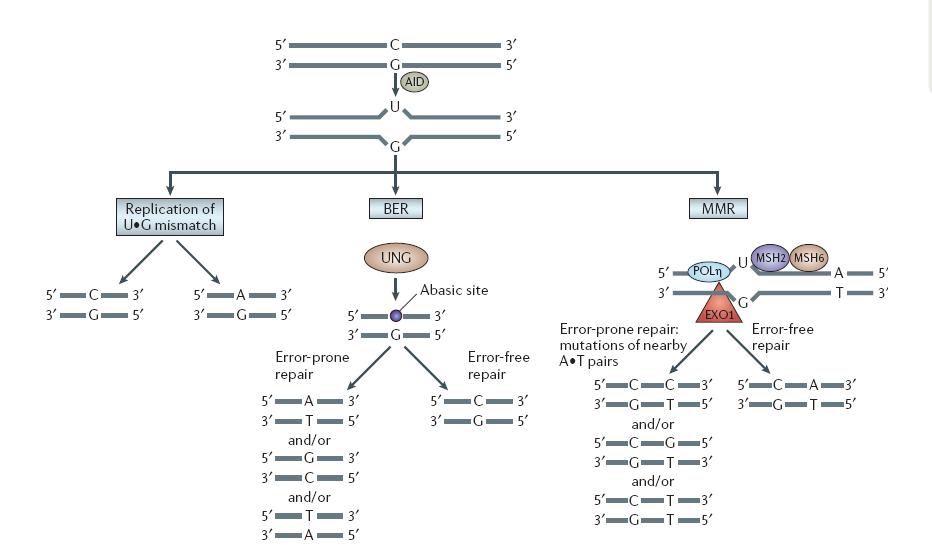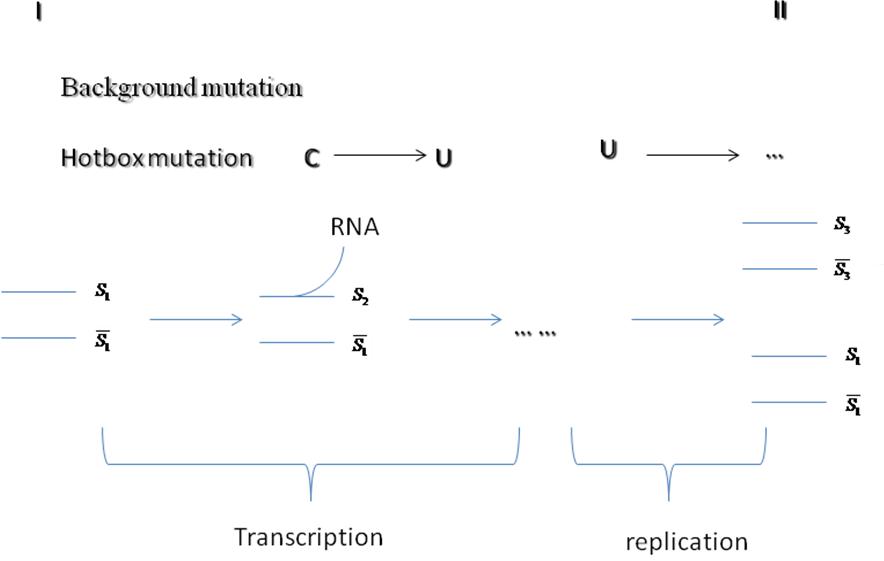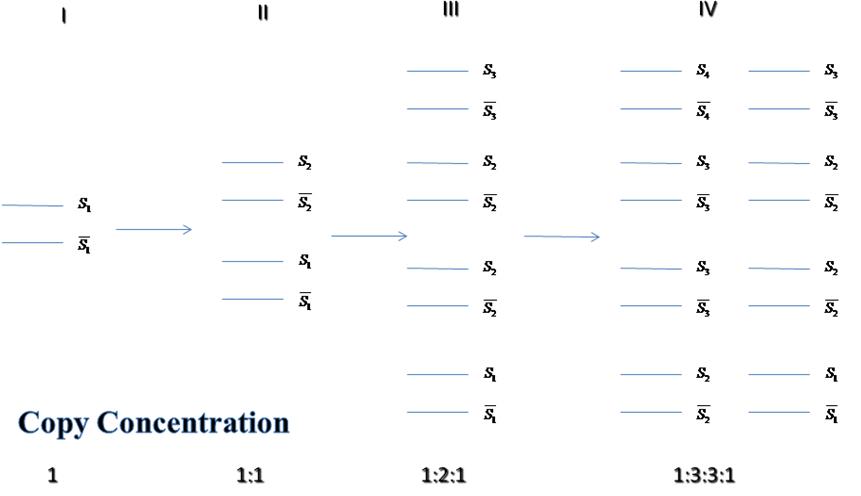Mutation Model
From 2008.igem.org
(Difference between revisions)
(→Part I Mutation Model) |
|||
| Line 1: | Line 1: | ||
=Part I Mutation Model= | =Part I Mutation Model= | ||
==Hypothesis== | ==Hypothesis== | ||
| - | + | *The mutation efficiency from the initial gene to the target gene should remain a continuous curve along reproduction, or along time. Here we discrete the mutation rate to be linear function according to the replication time (), which in fact create several discontiguous point. | |
| - | + | *DNA lesion repair rate appears high enough in replication than other cell activities, so that the DNA lesion repair rate can be conformed to background mutations except in replication process. | |
| - | + | *The whole yeast is large enough to obey the statistics rules | |
==Model Construction== | ==Model Construction== | ||
| - | + | *Probability Model <br>For each DNA sequence status, we take down a probability matrix for the coding sequence, which gives out each base appearance possibility on every site. The structure on each site is 5*1 matrix,(P<sub>a</sub>,P<sub>t</sub>,P<sub>c</sub>,P<sub>g</sub>,P<sub>u</sub>), and ΣP=1. Therefore, the whole sequence status is recorded as 5*length matrix.E.g. For the Gal4 DNA, with a length of 2646, one status is a 5*2646 matrix. | |
| - | + | *Scanning Model<br>The hotbox appearance rate on a specific site i is calculated as below. | |
{|align="left" | {|align="left" | ||
|[[Image:Peking hotbox search.jpg]] | |[[Image:Peking hotbox search.jpg]] | ||
|}<br><br><br> | |}<br><br><br> | ||
| - | W: a, t; R: a, g; H: a, c, g;<br> | + | :W: a, t; R: a, g; H: a, c, g;<br> |
| - | Hotbox appearrance rate P<sub>H</sub>=P<sub>W</sub><sup>(i-2)</sup>P<sub>R</sub><sup>(i-2)</sup>P<sub>C</sub><sup>(i-2)</sup>P<sub>H</sub><sup>(i-2)</sup>, and here (i) refers to the site i. | + | :Hotbox appearrance rate P<sub>H</sub>=P<sub>W</sub><sup>(i-2)</sup>P<sub>R</sub><sup>(i-2)</sup>P<sub>C</sub><sup>(i-2)</sup>P<sub>H</sub><sup>(i-2)</sup>, and here (i) refers to the site i. |
| - | + | *Model on DNA lesion repair<br>As reviewed by the paper, the U:G mismatch DNA lesion will be repaired in three pathways.Lacks of the knowledge on the preference of repair mechanism in yeast, we temporarily assume that mechanisms happen randomly. | |
| - | As reviewed by the paper, the U:G mismatch DNA lesion will be repaired in three pathways. | + | |
{|align="centre" | {|align="centre" | ||
|[[Image:Peking Repair.jpg]] | |[[Image:Peking Repair.jpg]] | ||
| Line 20: | Line 19: | ||
|''VH Odegard, DG Schatz. Targeting of somatic hypermutation. Nat Rev Immunol. 2006 Aug;6(8):573-83'' | |''VH Odegard, DG Schatz. Targeting of somatic hypermutation. Nat Rev Immunol. 2006 Aug;6(8):573-83'' | ||
|} | |} | ||
| + | *Copy Status distribution along replication | ||
| + | **Back ground mutations happen all the time in a fix rate. | ||
| + | **Hotspot mutation happens in the transcription process on the coding DNA, while the lesion repair happen at the replication. | ||
| + | **The figure below shows the whole process.S<sub>i</sub> is a sequence distribution matrix. | ||
| + | {|align="centre" | ||
| + | |[[Image:Mutation_map1.jpg]] | ||
| + | |} | ||
| + | {|align="centre" | ||
| + | |[[Image:Mutation_map2.jpg]] | ||
| + | |} | ||
| + | :After n times replication, Copy concentration proportion from S<sub>1</sub> to S<sub>n+1</sub> will be spread binomial expression of (1+1)<sub>n</sub>, which is C<sub>n</sub><sup>0</sup>:C<sub>n</sub><sup>1</sup>:<sub>n</sub><sup>2</sup>:...:C<sub>n</sub><sup>n</sup>. | ||
Revision as of 18:17, 29 October 2008
Part I Mutation Model
Hypothesis
- The mutation efficiency from the initial gene to the target gene should remain a continuous curve along reproduction, or along time. Here we discrete the mutation rate to be linear function according to the replication time (), which in fact create several discontiguous point.
- DNA lesion repair rate appears high enough in replication than other cell activities, so that the DNA lesion repair rate can be conformed to background mutations except in replication process.
- The whole yeast is large enough to obey the statistics rules
Model Construction
- Probability Model
For each DNA sequence status, we take down a probability matrix for the coding sequence, which gives out each base appearance possibility on every site. The structure on each site is 5*1 matrix,(Pa,Pt,Pc,Pg,Pu), and ΣP=1. Therefore, the whole sequence status is recorded as 5*length matrix.E.g. For the Gal4 DNA, with a length of 2646, one status is a 5*2646 matrix. - Scanning Model
The hotbox appearance rate on a specific site i is calculated as below.

|
- W: a, t; R: a, g; H: a, c, g;
- Hotbox appearrance rate PH=PW(i-2)PR(i-2)PC(i-2)PH(i-2), and here (i) refers to the site i.
- Model on DNA lesion repair
As reviewed by the paper, the U:G mismatch DNA lesion will be repaired in three pathways.Lacks of the knowledge on the preference of repair mechanism in yeast, we temporarily assume that mechanisms happen randomly.

|
| VH Odegard, DG Schatz. Targeting of somatic hypermutation. Nat Rev Immunol. 2006 Aug;6(8):573-83 |
- Copy Status distribution along replication
- Back ground mutations happen all the time in a fix rate.
- Hotspot mutation happens in the transcription process on the coding DNA, while the lesion repair happen at the replication.
- The figure below shows the whole process.Si is a sequence distribution matrix.

|

|
- After n times replication, Copy concentration proportion from S1 to Sn+1 will be spread binomial expression of (1+1)n, which is Cn0:Cn1:n2:...:Cnn.
 "
"